Task Force on Climate-related Financial Disclosures
Chunghwa Telecom is the first telecom operator in Taiwan that signed up for the Task Force on Climate-related Financial Disclosures (TCFD) initiative. Since 2020, it has been proactively performing analyses concerning the climate-related risks and opportunities based on the TCFD framework. With that, it pushes for efforts for climate change adaptation and mitigation, reducing risks in corporate operation and create opportunities for the industry.
Chunghwa Telecom also holds the distinction of being the first telecommunications company globally to complete independent assurance of its TCFD-aligned climate-related financial disclosures. From 2020 to 2023, the company consistently received the highest rating—Level 5 “Excellence”—in TCFD Conformance Verification conducted by BSI. In 2024, it achieved a Level A+ EXCELLENCE rating from TUV-NORD, further validating the comprehensiveness and rigor of its climate disclosure practices.
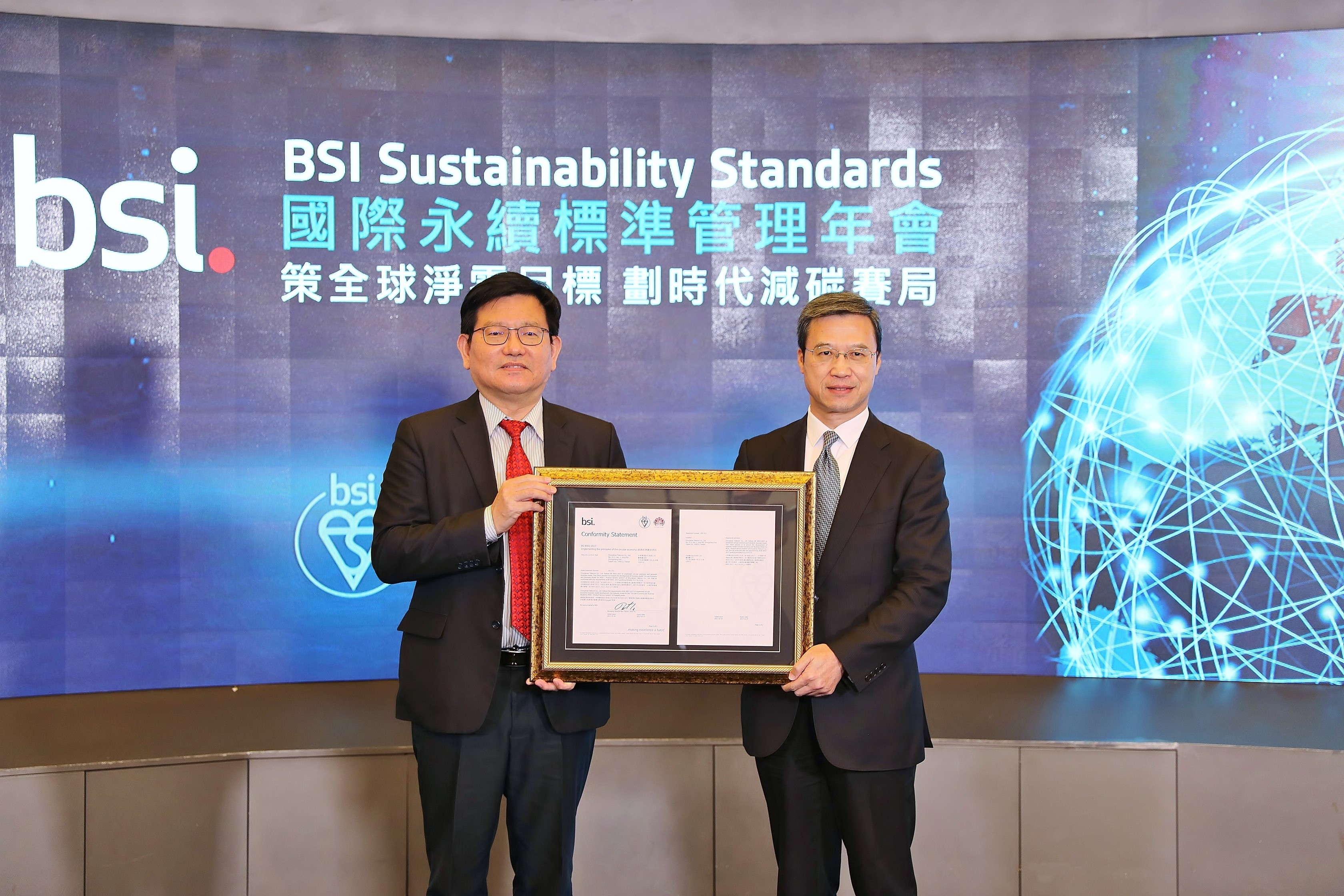
Chunghwa Telecom TCFD Disclosure
Chunghwa Telecom has conducted the analysis of climate related risks and opportunities based on the framework proposed by TCFD and has preliminary results. The following are the results of Chunghwa Telecom's implementation according to the four core elements of TCFD: "Governance", "Strategy", "Risk Management", and “Metrics and Targets".
Governance
Chunghwa Telecom’s risk management policy, structure and culture are approved by the Board of Directors, and has established the Risk Management Committee, with the President as the convener, reporting to the Board of Directors. In addition, the Sustainable Development Promotion Committee has been established at the Company, under which the Environmental (E) group is responsible for the management of the company-wide climate change mitigation and adaptation strategies and actions.
The group is tasked with the analysis and tracking of risks and opportunities of climate change. The Environmental (E) group and reports results to the Risk Management Committee for the Committee to perform a comprehensive assessment of the risks and implement necessary mitigation measures in line with the risk levels. The Environmental (E) group shall regularly produce the TCFD Assessment report for the reference of the Board of the Directors.
Strategies
To analyze the impacts of climate change on Chunghwa Telecom in the future, Chunghwa Telecom set a baseline scenario and a 1.5°C scenario in accordance with the TCFD framework to identify and analyze the short-, medium-, and long-term climate risks and opportunities in the business scope of the Company, the upstream and the downstream, and the entire life cycle of assets. IEA Stated Policies Scenario STEPs(Baseline Scenario) and IEA Net Zero Emissions by 2050 NZE (1.5°C scenario) are employed as the climate scenarios for climate mitigation strategies (transition risks). IPCC RCP 8.5 (baseline scenario) and IPCC RCP 2.6 (1.5°C scenario) are employed as the climate scenarios for climate adaptation strategies (physical risks).
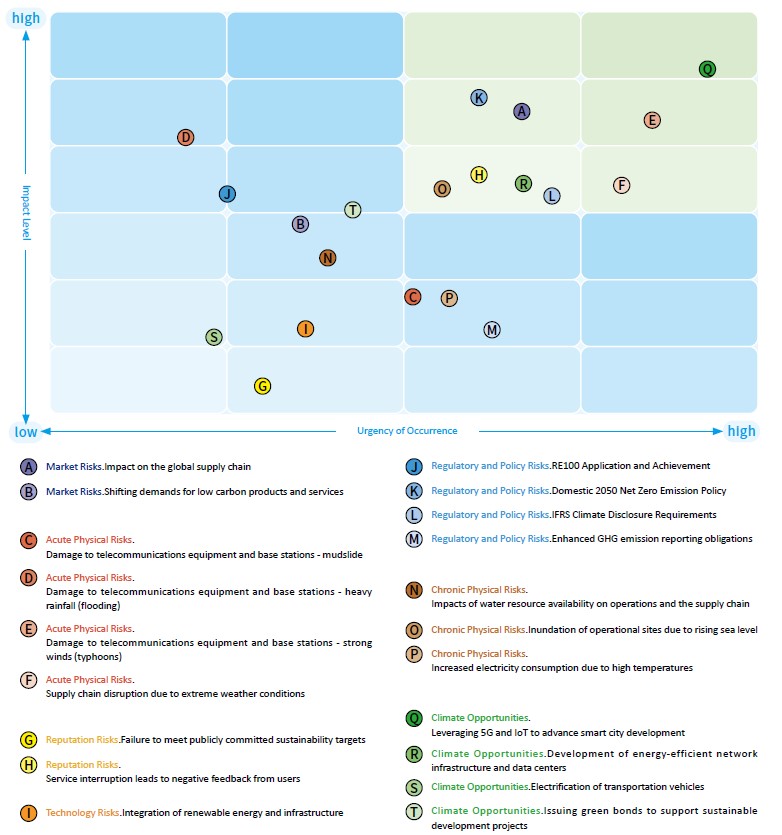
- Seven Climate-Related Risks
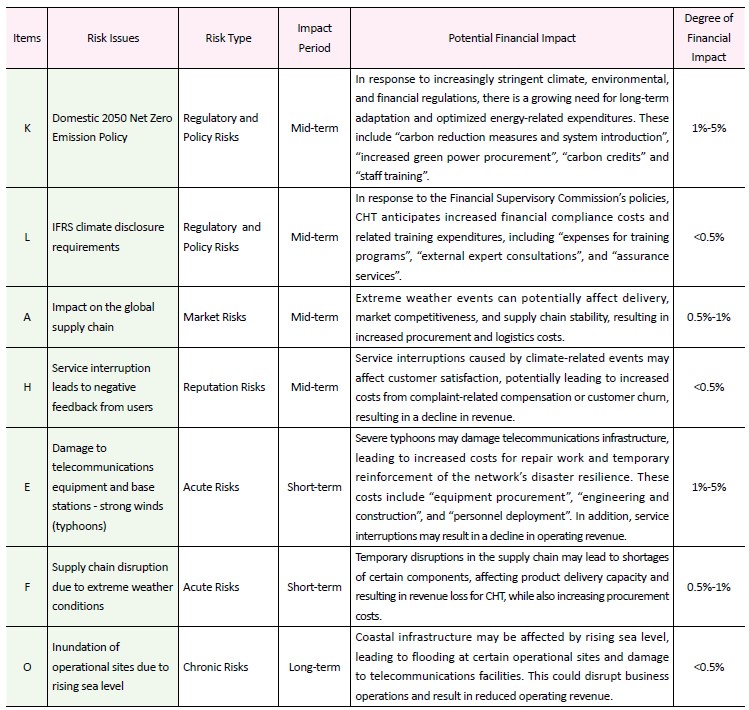
Note: The short-term is defined as the year 2025; the mid-term as 2026–2030; and the long-term as 2031–2050.
- Two Climate-Related Opportunities
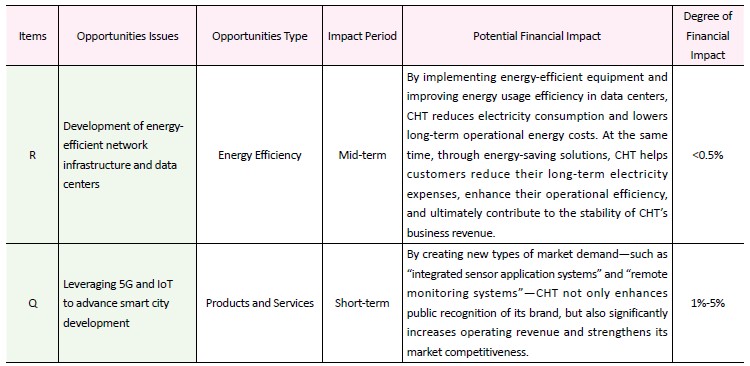
Note1: The short-term is defined as the year 2025; the mid-term as 2026–2030; and the long-term as 2031–2050.
Note2: In 2024, CHT gained NT$18.213 billion of revenue from the main climate opportunity related products and services, including Intelligent Green Building, Intelligent Video Surveillance, Intelligent Transportation System, Intelligent Environment Network, cloud, IDC and MOD with a cost of NT$15.345 billion. Based on the CAGR of 4.6% for the total revenue of these product lines in 2024-2027, the cumulative financial opportunity over 2025-2027 is approximately NT$59.822 billion.
Risk Management
In alignment with TCFD recommendations, Chunghwa Telecom identified short-, medium-, and long-term climate-related risks and opportunities by reviewing global industry risk management reports, Taiwan’s regulatory policies, and peer company disclosures. To enhance the robustness of this assessment, perspectives were gathered through interviews with senior managers across departments (internal departments) and independent directors (external). These interviews provided insights into the relevance, potential impact, and expected timing of each identified climate-related risk and opportunity.
In accordance with the TCFD recommendations, Chunghwa Telecom reviewed global industry risk management reports, Taiwan’s regulatory policies, and peer disclosures to identify climate-related risks and opportunities across the short, medium, and long term. Additionally, Chunghwa Telecom referred to the ISO 31000 Risk Management Guidelines to establish a climate risk management process. A hazard severity assessment methodology was adopted to evaluate risk levels (low, medium, high), using the following formula: Risk Severity = Likelihood × Impact Magnitude.
Starting in 2023, Chunghwa Telecom elevated its “Risk Management Committee” to a functional committee under the Board of Directors in 2023 and renamed the former management-level committee to “Risk Management Promotion Committee,” clearly delineating the roles of strategic oversight and operational execution, and thereby enhancing the hierarchical structure of the company’s risk governance framework.
The Environmental (E) Group under the Sustainable Development Promotion Committee is responsible for overseeing climate-related risk management activities, based on a climate risk and opportunity matrix. Its duties include formulating response strategies, setting implementation directions and management targets, and planning resource allocation. The results of related assessments are reviewed by the Sustainable Development Promotion Committee and regularly reported to the Risk Management Committee. The Risk Management Committee is responsible for integrating climate-related risks into Chunghwa Telecom’s broader enterprise risk assessment and for initiating appropriate mitigation measures based on the level of risk identified. To ensure the effectiveness of response strategies, Chunghwa Telecom conducts quarterly reviews of the implementation status and progress toward risk management targets. A mechanism for ongoing monitoring and evaluation has also been established to track performance continuously. Progress and outcomes are regularly reported to both the ESG Committee and the Board of Directors. Where necessary, adjustments are made based on actual implementation results to ensure timely achievement of the stated objectives.
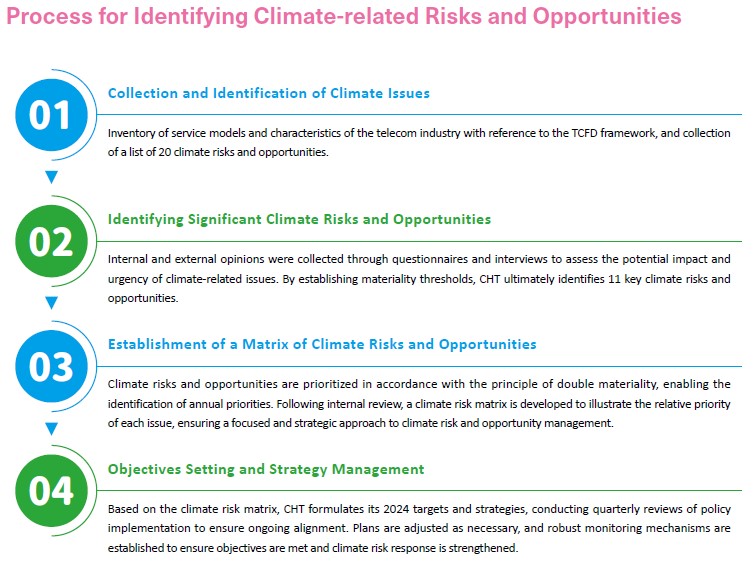
Metrics & Targets
Based on its two primary strategic initiatives—climate change mitigation and adaptation—Chunghwa Telecom has established corresponding metrics and set specific targets to manage the company’s identified climate-related risks and opportunities. These targets are designed to support effective risk control and opportunity realization.
| Risk / Opportunity | Corresponding Material Item | Metric | Target | Performance in 2024 |
|---|---|---|---|---|
| Renewable energy use | RE100: 100% renewable energy use by 2040 | A total of 72.604 million kWh of renewable energy was procured and self-generated for use | ||
| PUE of IDCs | Low-Carbon Technology for IDC Data Centers: Below 1.5 in 2030 (with 2020 as baseline year) | The PUE was 1.61, with an annual improvement rate of approximately 0.6% to 1%. | ||
| Increased electricity bills due to changes in the energy mix of Taiwan | Severity of climate disasters | Deployment of relevant plans in line with the short, medium and long-term climate change adaptation plans | Please see Attachment | |
| Opportunity | Development of Energy-Efficient Network Infrastructure and Data Centers | Revenues from green products and services | Expanding Global Data Center Opportunities Low-Carbon Technology for IDC Data Centers: Below 1.5 in 2030 (with 2020 as baseline year) |
The PUE was 1.61, with an annual improvement rate of approximately 0.6% to 1%. |
Documents
-
TCFD Conformity Statement.pdf
-
CHT 2024 TCFD Task force Climate-related Financial Disclosures
-
TCFD Adaptation Plans for Climate Change in the Short-/Mid-/Long-term of Chunghwa Telecom
-
TCFD Climate-Related Scenario, Physical Risk.pdf
-
Climate Change Transition Risk - Regulatory Change Risk.pdf


